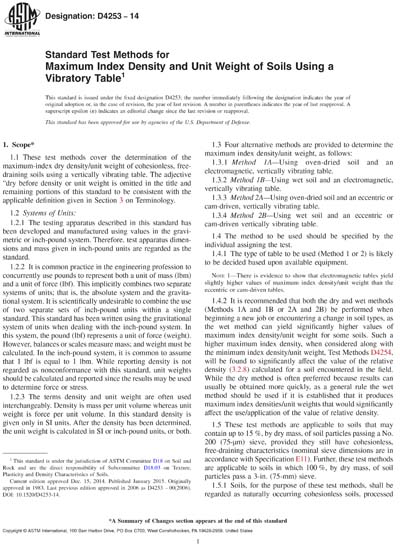Historical
ASTM D4253-14
Standard Test Methods for Maximum Index Density and Unit Weight of Soils Using a Vibratory Table
1.1 These test methods cover the determination of the maximum-index dry density/unit weight of cohesionless, free-draining soils using a vertically vibrating table. The adjective “dry before density or unit weight is omitted in the title and remaining portions of this standard to be consistent with the applicable definition given in Section 3 on Terminology.
1.2 Systems of Units:
1.3 Four alternative methods are provided to determine the maximum index density/unit weight, as follows:...
1.4 The method to be used should be specified by the individual assigning the test.
1.6 These test methods will typically produce a higher maximum dry density/unit weight for cohesionless, free-draining soils than that obtained by impact compaction in which a well-defined moisture-density relationship is not apparent. However, for some soils containing between 5 and 15 % fines, the use of impact compaction (Test Methods D698 or D1557) may be useful in evaluating what is an appropriate maximum index density/unit weight.
1.7 These test methods will typically produce a lower maximum dry density/unit weight than that obtained by vibrating hammer using Test Method D7382.
1.8 For many types of free-draining, cohesionless soils, these test methods cause a moderate amount of degradation (particle breakdown) of the soil. When degradation occurs, typically there is an increase in the maximum index density/unit weight obtained, and comparable test results may not be obtained when different size molds are used to test a given soil.
ASTM International [astm]

